The Indiana Bat (Myotis sodalis) is a federally endangered species and is found mostly in Indiana and the surrounding states. It spends winters in Indiana hibernating in caves and mines where it can tolerate low temperatures better than other bats because it has a higher surface-area to volume ratio. Indiana is their only known wintering ground.
- Status: Endangered
- Known as: Indiana Bat.
- Estimated numbers left in the wild: 244,000.
The bat population is estimated at 244,000 of which most are spread out across Indiana with some found as far north as Ohio and Pennsylvania during summer months.
Though not much research has been done on the specific reasons for this decline, there are many factors that could be contributing to its endangerment including habitat loss due to agriculture, old-growth forest logging, and mining; disturbance of hibernation sites; White-Nose Syndrome (WNS); and wind energy development.
The bat was first listed as federally endangered in 1967. The hibernating bats are one of four species of bats that live in Indiana. The other three species are the tri-colored bat, red bat
Description

A tiny winged insectivore from the central United States, the bat is about 5 centimeters long, has a wing:span of around 25 centimeters, and weighs 4 to 10 grams. The fur of this bat is dark brown to black, sometimes with a grey tinge. It is otherwise a typical bat in outward appearance.
Bats mate in the fall, usually in October and November. The bats form mating colonies of 50 to 100 individuals. Females give birth to a single pup in June or July and nurse it until it is able to fly on its own, which takes about six weeks.
In Indiana, the bat is considered endangered. The main reason for this is their declining population. In the 1970s, they were estimated to have a population of around 1 million. However, by the early 2000s, that number had decreased to 300,000. There are several reasons for this decline.
Location
Bats are found throughout the eastern and central United States, though as their name suggests, a large concentration is found in Indiana. Other major populations are located in the states of New York, Illinois, Kentucky, and Missouri.
In summer, bats live in forested areas near watercourses where many insects are available. In winter, they hibernate in caves and sometimes abandoned mine-shafts.
Anatomy and Appearance
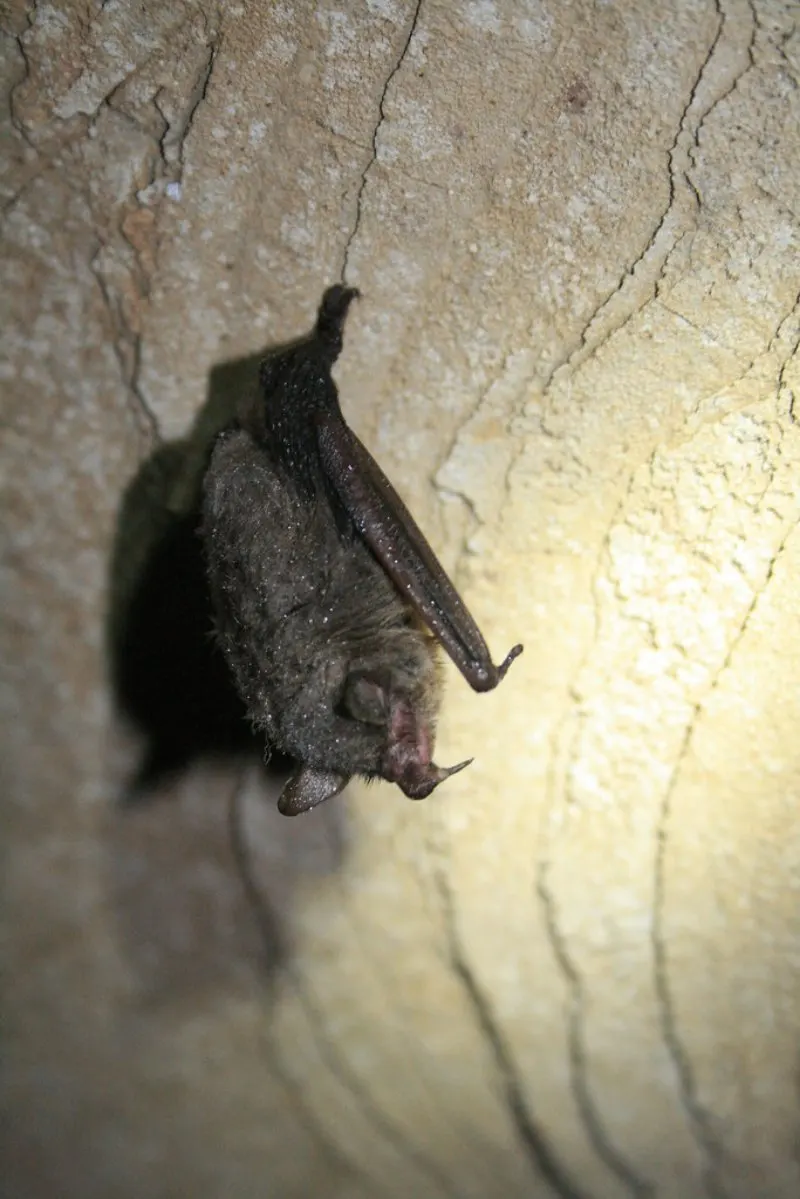
The Indiana bat is a small bat, measuring only 3 to 5 inches in length with a wingspan of 8 to 9 inches. It has a reddish-brown fur on its back and is lighter underneath.
The Indiana bat’s most distinguishing feature is the black membrane that stretches from its nose across the eyes and covers the entire ear. This membrane, called the “myotis” or “mouse-eared” membrane, gives the Indiana bats its common name.
The bat is the only species of bat found in Indiana. It is also found in Kentucky, Illinois, Missouri, Tennessee, and West Virginia.
The Indiana bat is a migratory species and spends winters in Indiana hibernating in caves and mines where it can tolerate low temperatures better than other bats because it has a higher surface-area
Indiana Bat Habitat
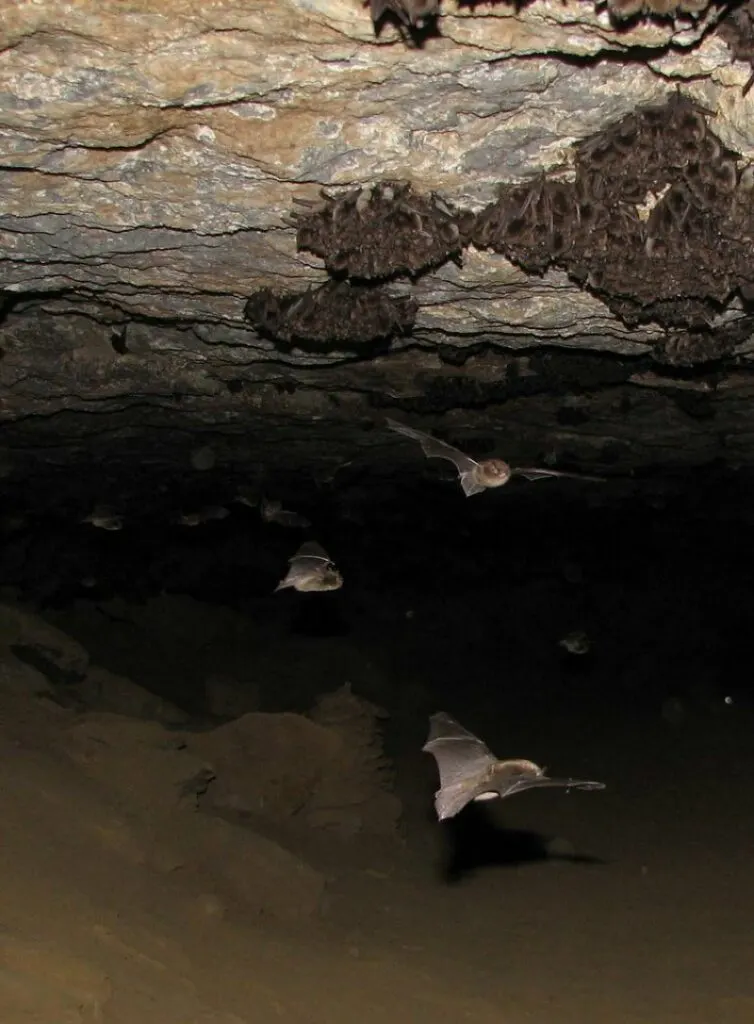
Indiana bats live in Indiana as well as a few other southern states. Indiana is an important habitat for bats because they spend their winters there. Indiana is the only known wintering ground for bats.
Indiana is the only known wintering ground for the bat species, and it’s critical to preserve Indiana’s caves and mines that provide protected upland habitats during the winter.
Some of Indiana’s caves and mines have been lost or altered by human development, but some have been preserved by state parks, nature preserves, and private landowners who create artificial hibernacula from unused buildings.
Those sites are monitored periodically to see if the Indiana bat population is healthy enough to return to those sites for hibernation.
In winter, Indiana bats retreat to caves in huge numbers. They will only live in caves with particular internal conditions, including a temperature below 10 C but above 0 C. This limits their hibernation habitat to a minimal selection of caves and old mines.
They hibernate for roughly half the year, living off their fat reserves.
Young bats are raised during the summer months under the bark of dead trees, whereas many as 100 females may gather in a maternity colony to raise their young. Bats may live up to 20 years in the wild, but a lifespan of 14 years is more typical.
Indiana Bat Diet and Nutrition
Indiana bats’ diet includes insects, such as moths and beetles. The bat is not a picky eater and will eat what it can find.
The species is a great advantage for humans because Indiana bats are able to eat the bugs that we cannot. This bat prefers to eat flying insects while they are still in flight, but they will also eat the insects on plants and the ground.
During the summer, the bats consume huge numbers of insects at night, hunting their quarry with the help of echolocation and eating up to half their own weight every night. Mosquitoes, moths, midges, beetles, and other night-flying insects are all consumed by this bat.
When daylight comes, the bat retreats beneath the loose bark of dead or dying trees and sleeps.
These bats consume many insects harmful to humans or their crops and perform a valuable role in controlling insects for the overall ecological balance.
Indiana Bat Mating Habits
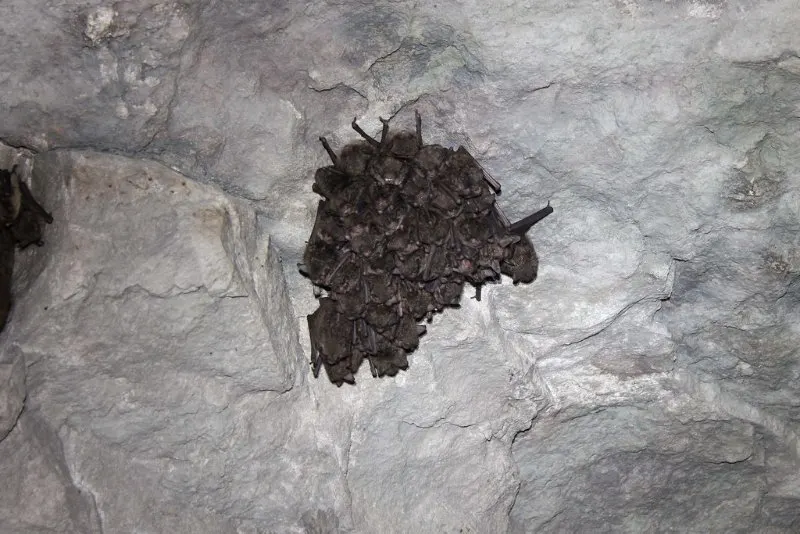
The bat is a sexually dimorphic species, which means the males and females look different from one another.
The male Indiana bat is significantly larger than the female and has a dark brown to black coat. The female bat is smaller and has a light-colored coat. Indiana bat babies are the color of the female Indiana bat.
People who study bats saw that Indiana bats hibernated in caves and mines where they could tolerate low temperatures better than other species because they have a higher surface-area to volume ratio.
Scientists studying bats noticed hibernating bats were disappearing from hibernation sites during the winter. This disappearance was not normal, so they decided to study the bat hibernation habits.
Mating season for the bat is typically in late winter or early spring, right before they migrate to their summer roosting sites. The bats mate in groups and the males will compete with each other for the opportunity to mate with the females.
After mating, the males will leave and the females will give birth to one or two young bats.
The young bats will stay with their mother until they are able to fly and fend for themselves, which is usually a few weeks. Indiana bats rely on their mothers for warmth and protection, without those things the bat babies will not survive long.
Maternity Colonies
One of the most important aspects of bat conservation is protecting their maternity colonies. A maternity colony is a group of female bats that give birth to their young in one location. They typically give birth in the late spring or early summer, so May through July is when bat surveys take place.
They like like to make their maternity colonies in large, open-ceiling areas in caves and mines. They choose these spaces because they are the most protected from the elements and predators; they bats raise their young for about 45 days before they go out to hunt on their own at night, then return before sunrise to the colony to rest.
Indiana bats are extremely important for the health of our environment. Bats consume large quantities of insects, including many pests that can damage crops. A single bat can eat up to 3,000 mosquitoes in one night! Indiana bats also play an important role in pollinating flowers and trees.
Indiana Bat Group Structure
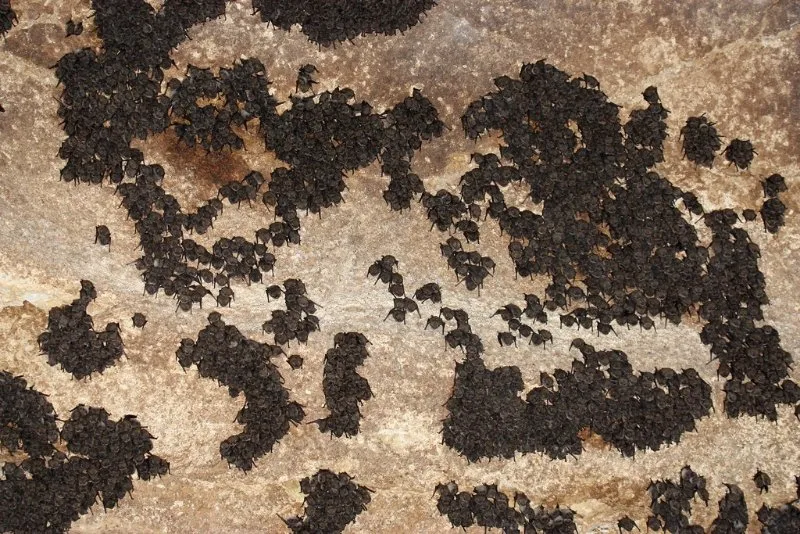
The Bat is a monophyletic Group. It is monophyletic because it has traits that are different from other groups.
For example, the Bat cannot fly well and is not very agile in the air like other bats. Indiana has the distinction of being home to four different species of bats.
Indiana’s state bat, is a federally endangered species and found mostly in Indiana and surrounding states in summer and autumn and during winter time it hibernates in caves and mines in Indiana where it can tolerate low temperatures better than other bats because it has a higher surface-area to volume ratio.
This makes Indiana its only known wintering ground.
Indiana Bat Role in the Ecosystems
The Indiana bat plays a very important role in Indiana and the surrounding areas and is important for Indiana’s ecosystem.
Indiana, thanks to its four different species of bats, has very high biodiversity and is home to the bat that is one of the most endangered animals in Indiana. The Bat is also ecologically efficient, eating up to 600 grams of insects every night.
They Bat are ecologically efficient because they are able to adapt better when their habitat changes. They are able to adapt to new habitats by recolonizing the area due to their low body weight.
Indiana also has many caves with large numbers of these big brown bats. Indiana’s ecosystem benefits from this because they eat up to 600 grams of insects.
Indiana Bat and Human Relationship
The bat has had a long and complicated relationship with humans.
They was once one of the most common bats in Indiana, but its population has declined significantly in recent years. There are several reasons for this decline, including habitat loss, white-nose syndrome, and wind turbines.
Wind turbines have been a particularly controversial issue for the bat. Indiana bats are attracted to the turbines because they look like tall trees, and many bats have been killed by the blades.
In an effort to protect the bats, some companies have started to build “bat houses” near the turbines. While this is a step in the right direction, more needs to be done to protect Indiana’s state bat.
Indiana Bats vs Other Bat Species
The bat is one of four distinct bat species that can be found in Indiana. These species a federally protected species, indicating that it faces an imminent risk of extinction.
The three additional bat species in Indiana are not under any conservation threat. they hibernate in caves and mines during the cold winter, which is why they are able to survive in colder climates than other bats. Indiana is the only state where the bat sleeps throughout the winter.
There are many reasons that Indiana bats are endangered. First, Indiana is one of the only places that bats hibernate during the winter. Bats live largely in Indiana but also surrounding states. Indiana is the only state where they are known to hibernate over winter.
If Bat populations were lost in Indiana it would be very difficult for them to repopulate because Indiana is the only place Indiana bats like to hibernate.
Second, Indiana bats are made endangered because of their need for roosting places that are safe and well protected from people and other animals. Bats have a very specific habitat preference so they will not move into a cave or mine that does not have the right conditions for them.
They hibernate in caves and mines where the temperature is stable and they are well protected from people and other animals. If Indiana bats cannot find a safe place to roost, they will not be able to survive.
Third, Indiana bats are also endangered because of their low population size. Bats have a low population size because they only mate once a year and the female Indiana bat only gives birth to one baby bat per year.
Indiana bats are also killed by people and other animals when they are outside of their hibernation caves.
Fourth, Indiana bats are endangered because they are susceptible to many different diseases. Indiana bats can catch diseases from other animals that they interact with, like birds, raccoons, and skunks. Indiana bats are also susceptible to the disease White-nose syndrome that is killing many other bat species in Indiana and surrounding states.
Indiana Bat Facts
Here are the interesting facts about Indiana bats
- The Indiana bat is a state bat.
- Indiana is home to four different species of bats and the Indiana Bat is one of them.
- They are federally endangered and it primarily inhabits Indiana and other surrounding states.
- These species are federally endangered
- These species spend their winters hibernating in caves and mines
- Indiana bats have a higher surface-area to volume ratio that makes it able to tolerate low temperatures better than other species
- Indiana is the These species only known wintering ground
- This tiny species of bat has a wingspan of 9 – 12 inches and weighs about 3/4 of an ounce.
- Indiana bats roost in trees but also roost in the leaves of the bat such as Indiana’s state tree, sugar maples, Indiana’s state animal, Indiana’s state insect, and more.
Conservation Status
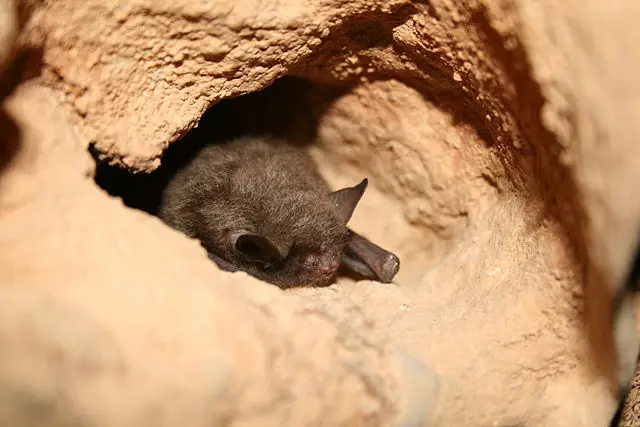
The Indiana bat is on the verge of extinction, an endangered speciest. Four species of bats live in Indiana.
The Indiana bat (Myotis sodalis) is a federally endangered species that hibernate in Indiana mines and caves, where their high surface-area-to-volume ratio allows them to survive colder temperatures than other bats.
The Indiana bat was once common throughout Indiana and the eastern United States, but their populations have declined drastically in recent years. They are threatened by loss of habitat, disturbance while hibernating, and White-nose Syndrome.
The Indiana bat is listed as a federally endangered species, and there are several programs in place to help protect it. The Indiana bat is also protected under the Indiana Endangered Species Act. The Indiana Department of Natural Resources is working with landowners to create conservation areas and restore habitat for the Indiana bat.
See Related: Fascinating Facts About Conservation
Threats
The Indiana Bat has only reproduced in the Indiana area for the past 20 years. This winter, there are fears that this species will not be able to survive because many of Indiana’s mines have been closed over the past years.
There are four different species of bats in Indiana which need either caves or mines to live in during hibernation.
Alternative habitats have been built for these other three species, but no work has been done on building an alternative habitat for the Indiana bat because they reproduce mainly through mating with close relatives- something very rare among mammals.
It is time that work starts being done to help protect this fragile species of bat found mostly in Indiana.
Habitat Loss
Habitat loss and fragmentation are naturally one of the threats to the bat. These bats require forested land, and logging or other lands “improvement” projects can seriously affect the local availability of suitable living spaces.
Furthermore, insecticides and pesticides likely poison many of these bats, besides cutting back on the number of insects available in certain areas during the summer.
Human activity also directly threatens these bats. Cave tours to view the bats can be highly destructive despite the essentially benign intentions of those going on them.
Indiana bats dislike disturbances while hibernating and move to another spot, putting large numbers at serious risk during a cold season when their food is lacking.
Attempts to shield the bats by building gates in the cave mouths can be harmful also if they are built improperly – dangerously changing conditions inside the cave or accidentally excluding the very bats they are meant to protect.
White-nose Syndrome
White-nose Syndrome is a fungal infection that has killed millions of bats since it was first discovered.
White-nose syndrome is a disease associated with bats in Indiana. It is caused by the fungus Geomyces destruction.
Indiana bat populations in Indiana have been affected by the growth of white-nose syndrome. These species hibernation sites are also at risk for degradation because of Indiana bat white-nose syndrome.
See Related: Endangered Species in California
Conservation efforts
Indiana bats are fully protected by law, harming, harassing, or killing the animals being specifically illegal. Gates are built in some critical cave mouths to keep people from entering and disturbing the hibernating bats.
The Conservation Fund and other organizations are also working to extend fully protected areas where the bats can live undisturbed. At the same time, educational outreach programs acquaint people with the beneficial behavior of these bats and the reasons why they are an important natural heritage that should be preserved.
Organizations
Organizations that help conserve Indiana bats include the Indiana Natural Heritage Database, Indiana Department of Natural Resources, U.S. Fish and Wildlife Service, Bat Cave Preserve Commission, Indiana Biodiversity Knowledgebase, and Bat Working Group.
Indiana Natural Heritage Database
The Indiana Department of Natural Resources Indiana Bat Conservation Program is responsible for the conservation of hibernating Indiana bats. Indiana has two main strategies to conserve the bats:
1) Gather information about the bats so that Indiana can better protect them.
2) Reduce or eliminate human-caused mortalities of these bats.
The Bat Conservation Program involves the examination of Indiana bat populations, monitoring their status, and documenting bat activities. The INDNR collaborates with other agencies by providing endangered species protection, developing critical habitats, and conducting research on Indiana bats’ biology and ecology.
Indiana Department of Natural Resources
The Indiana Department of Natural Resources is also funding I conservation. The Indiana Bat is the only Indiana mammal on the Indiana Threatened Species List. The Indiana Bat is Indiana’s state bat. Indiana has the distinction of being home to four different species of bats.
They are Indiana’s only native land mammal and their populations have declined by about 97% since 1960 because people living near caves where Indiana bats hibernate started spraying household insecticides, especially in the 1950s and early 1960s when DDT use was high.
It spends winters in Indiana hibernating in only a few caves and mines where it can tolerate low temperatures better than other bats because it has a higher surface-area to volume ratio.
Indiana Bat Cave Preserve Commission
The Indiana Bat Cave Preserve Commission is a government entity that was created in order to protect the Indiana bats.
The commission is responsible for managing and administering the Indiana bats cave preserve, which is a preserve that is dedicated to the conservation of the endangered Indiana bat.
The commission is also responsible for working with landowners to ensure that the habitat of the brown bat is protected.
Do you know of or are you a part of an organization that works to conserve the Indiana Bats? Then please contact us to have it featured on Our Endangered World.
Final Thoughts
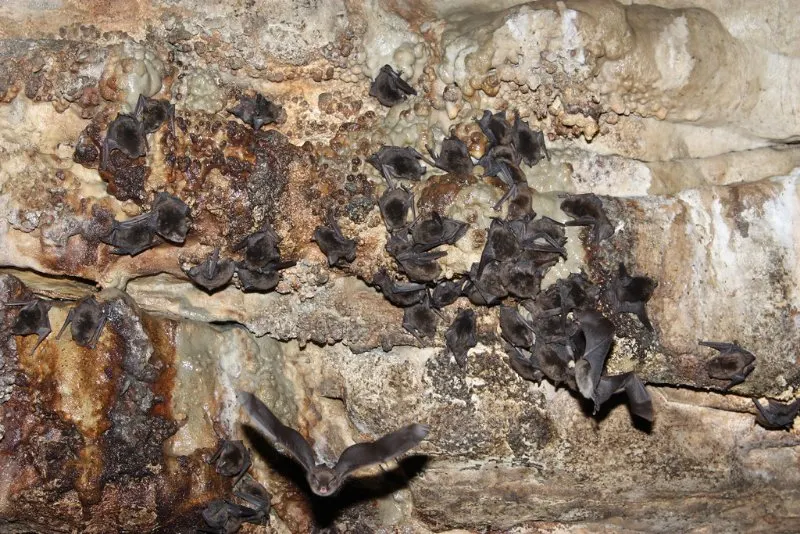
Indiana bats are Indiana’s state bat. Indiana has the distinction of being home to four different species of bats.
Indiana’s state bat and they spend winters in Indiana hibernating in caves and mines where it can tolerate low temperatures better than other bats because it has a higher surface-area to volume ratio.
Indiana is in desperate need of Indiana bats’ return, so the Indiana Department of Natural Resources is also funding Indiana Bat conservation.
Indiana is their only known wintering ground and they spend winters in Indiana hibernating in caves and mines where it can tolerate low temperatures better than other bats because it has a higher surface-area to volume ratio.
The Indiana Bat is Indiana’s state bat and is Indiana’s only native land mammal. Their populations have declined by about 97% since 1960 because people living near caves where they hibernate started spraying household insects.
Indiana bats are an important part of Indiana’s ecosystem, Indiana is in desperate need of their return. Indiana Bat Cave Preserve Commission was created to protect the Indiana bat habitat.
The Indiana Bat Conservation Program involves the examination of bat populations, monitoring their status, and documenting Indiana bats activities by collaborating with other agencies by providing endangered species protection, developing critical habitats, and conducting research on Indiana bats’ biology and ecology.
FAQ
Indiana Bat why are they endangered?
Indiana has the distinction of being home to four different species of bats. The bat or Myotis sodalis, is a federally endangered species and is found mostly in Indiana and the surrounding states.
The bat Conservation Program involves the examination of Indiana bat populations, monitoring their status, and documenting Indiana bat activities by collaborating with other agencies by providing endangered species protection, developing critical habitats, and conducting research on the bats’ biology and ecology.
How do you identify an Indiana bat?
You can identify Indiana bats by the following description: They are species of free-tailed bat that is endemic to Indiana, Kentucky, and Tennessee forested areas.
You can typically find a bat in a cave or mine near where they feed over the summer months and summer habitat. They remain inactive throughout winter hibernation until their return in late March or early April each year.
What do we know about where they live?
The bat spends winters in Illinois hibernating in caves and mines where it can tolerate low temperatures better than other bats because it has a higher surface area to volume ratio.
Are there any Indiana bat preserves?
Yes, the Indiana Bat Cave Preserve Commission is a government entity that was created in order to protect the bat.
The commission is responsible for managing and administering the Indiana bat cave preserve, which is a preserve that is dedicated to the conservation of the bat.
The commission is also responsible for working with landowners to ensure that the habitat of the bat is protected.
What can I do to help the Indiana bat?
You can contact your local bat conservation group or the Indiana Department of Natural Resources to see how you can get involved.
There are many ways that you can help, such as volunteering, donating money, or spreading awareness about the bat.
Indiana Bat Cave Preserve Commission was created to protect the brown bat habitat. Indiana Department of Natural Resources is also funding the bat conservation.
Other Species Profile
Related Resources
